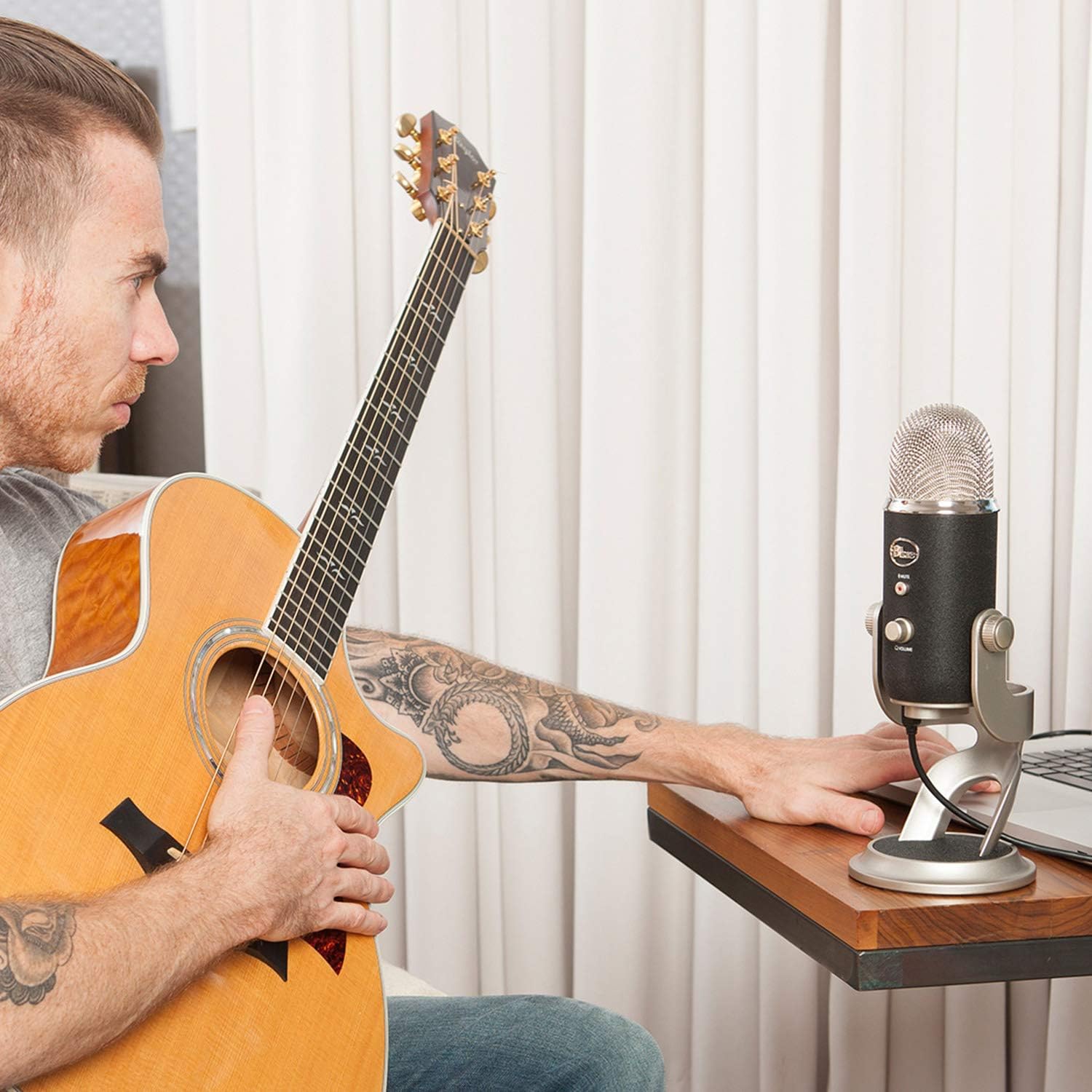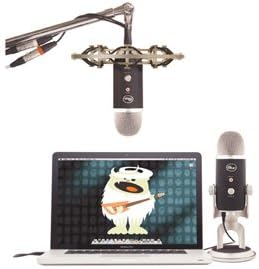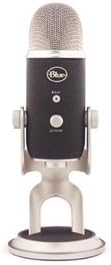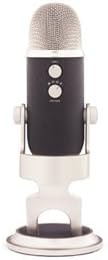Blue Yeti Pro Review
The Blue Yeti Pro is a standout in the world of USB microphones, blending high-quality audio recording with a unique hybrid design that appeals to both beginners and seasoned audio professionals. Launched as an upgrade to the wildly popular Blue Yeti, the Yeti Pro brings additional features like XLR connectivity and higher recording resolution, making it a compelling choice for podcasters, streamers, musicians, and voice-over artists. In this review, we’ll explore the Blue Yeti Pro’s design, functionality, sound quality, and overall value to help you decide if it’s the right microphone for your needs.
Blue Yeti Pro Review
Blue Microphones, now under the Logitech umbrella since 2018, has long been a trusted name in the audio industry. The original Blue Yeti, released in 2009, became a go-to microphone for content creators due to its ease of use, affordability, and versatility. The Yeti Pro builds on this legacy by adding professional-grade features while maintaining the plug-and-play simplicity that made its predecessor a hit.
Priced at around $249.99 (though often available for less during sales), the Yeti Pro sits at the higher end of Blue’s consumer microphone lineup. It’s marketed as a hybrid device, offering both USB and XLR outputs, which sets it apart from most USB microphones. This dual-connectivity feature, combined with a 24-bit/192kHz recording resolution, promises studio-quality sound in a compact, user-friendly package. But does it live up to the hype? Let’s dive in.
Design and Build Quality
The Blue Yeti Pro retains the iconic retro aesthetic of the standard Yeti, resembling a vintage studio microphone with a modern twist. It stands approximately 11.6 inches tall (including its base) and weighs a hefty 3.5 pounds, giving it a solid, premium feel. The microphone is constructed from metal, with a matte black finish that exudes professionalism and durability. Its robust build ensures it can withstand regular use, whether on a desk or mounted on a stand.
The included desktop stand is equally sturdy, featuring a wide base with rubber padding to minimize vibrations and desk noise. The microphone pivots smoothly on the stand, allowing you to adjust its angle for optimal positioning. For those who prefer more flexibility, the Yeti Pro can be detached from the base and mounted on a standard microphone stand or boom arm via its threaded bottom.
On the front, you’ll find a mute button with a red LED indicator (solid when active, flashing when muted) and a headphone volume knob. The back houses a gain control knob and a pattern selection switch. While the buttons and knobs feel tactile and responsive, some users have noted that the mute button can be a bit loud when pressed, which might be an issue during quiet recordings. Overall, the design is both functional and visually appealing, making it a great addition to any recording setup.
Features and Specifications
The Blue Yeti Pro is packed with features that cater to a wide range of recording needs. Here’s a breakdown of its key specifications:
- Microphone Type: Condenser
- Polar Patterns: Cardioid, Omnidirectional, Bidirectional, Stereo
- Sample Rate: 24-bit/192kHz (USB), 24-bit/96kHz (XLR)
- Frequency Response: 20Hz – 20kHz
- Max SPL: 120dB
- Connectivity: USB and XLR (stereo breakout cable included)
- Headphone Output: 3.5mm jack with zero-latency monitoring
- Weight: 1.55 lbs (mic only), 3.5 lbs (with stand)
- Dimensions: 4.72 x 4.92 x 11.61 inches (with stand)
Hybrid Connectivity
The standout feature of the Yeti Pro is its dual USB and XLR outputs. The USB connection allows for plug-and-play simplicity, making it ideal for beginners who want to record directly to a computer without additional gear. The XLR output, on the other hand, lets you connect the microphone to an external preamp or audio interface, offering greater control over your sound—a boon for professionals who already own high-end recording equipment.
Four Polar Patterns
Like the standard Yeti, the Pro model features four switchable polar patterns, controlled via a dial on the back:
- Cardioid: Ideal for solo recording, such as podcasts, voice-overs, or streaming. It captures sound from the front while rejecting noise from the sides and rear.
- Omnidirectional: Picks up sound from all directions, perfect for conference calls or multi-person recordings in a single room.
- Bidirectional: Records from the front and back, making it suitable for interviews or duets.
- Stereo: Uses both left and right channels for a wider soundstage, great for recording instruments or immersive audio.
This versatility makes the Yeti Pro adaptable to almost any recording scenario, from solo commentary to multi-instrument sessions.
High-Resolution Audio
The Yeti Pro boasts a 24-bit/192kHz sample rate over USB, a significant step up from the standard Yeti’s 16-bit/48kHz. This higher resolution captures more detail and clarity, especially for music recording or professional voice work. When using the XLR output, the sample rate drops to 24-bit/96kHz, which is still impressive for a microphone in this price range.
Zero-Latency Monitoring
The built-in 3.5mm headphone jack provides real-time monitoring with no delay, a crucial feature for musicians and podcasters who need to hear themselves as they record. The headphone amplifier is powerful, delivering clear audio even at moderate volumes.
Setup and Ease of Use
Setting up the Blue Yeti Pro is straightforward, though it varies slightly depending on your chosen connection method. For USB use, simply plug the included USB cable into your computer, select the Yeti Pro as your input/output device in your system settings, and you’re ready to go. On macOS, it’s fully plug-and-play with no additional drivers required. Windows users, however, need to download a driver from Blue’s website to unlock the full functionality, which adds a minor step to the process.
For XLR use, you’ll need an audio interface or mixer with phantom power, as well as the included stereo breakout cable (which splits the XLR output into two mono channels). This setup is more complex but offers greater flexibility for advanced users.
The onboard controls—mute, headphone volume, gain, and pattern selection—are intuitive and require no software tweaking during recording. However, Blue’s Sherpa software (available for free) allows you to fine-tune settings like gain and polar patterns from your desktop, adding an extra layer of convenience.
Sound Quality
The Blue Yeti Pro delivers impressive audio performance for its price point, thanks to its tri-capsule array and high-resolution recording capabilities. In cardioid mode, it produces a warm, full-bodied sound with crisp highs and solid low-end presence—perfect for vocal recordings. The microphone excels at capturing nuance, making it a strong choice for podcasters and voice-over artists who want professional-sounding results without a steep learning curve.
In stereo mode, the Yeti Pro shines for music recording, offering a wide, detailed soundstage that’s surprising for a USB microphone. Acoustic guitar, vocals, and even subtle ambient sounds come through with clarity, though it’s not a replacement for dedicated studio condensers in high-end production environments.
The omnidirectional and bidirectional modes are equally competent, though they’re more sensitive to room noise due to their wider pickup patterns. This can be a double-edged sword: great for capturing group discussions, but challenging in untreated spaces where background noise becomes an issue.
Compared to the standard Yeti, the Pro model offers a noticeable improvement in clarity and depth, especially at higher sample rates. The XLR output further enhances its potential, allowing you to pair it with a quality preamp for even better results. However, some users have reported that the Pro’s output gain is lower than the standard Yeti’s, requiring more gain adjustment to achieve the same volume levels—a minor quirk that doesn’t detract from its overall quality.
Pros and Cons
Pros
- Hybrid USB/XLR Design: Offers flexibility for both beginners and pros.
- High-Resolution Audio: 24-bit/192kHz recording delivers detailed sound.
- Versatile Polar Patterns: Four modes cover a wide range of recording needs.
- Solid Build Quality: Durable and stylish, with a premium feel.
- Zero-Latency Monitoring: Essential for real-time audio feedback.
Cons
- Price: At $249.99, it’s a significant investment compared to the standard Yeti ($129.99).
- Lower Output Gain: Requires more gain adjustment than the standard model.
- Size and Weight: Bulky and heavy, which may not suit portable setups.
- Driver Requirement (Windows): Not fully plug-and-play on all systems.
- Noise Sensitivity: Picks up background noise in untreated rooms, especially in omni mode.
Comparison to Alternatives
Blue Yeti ($129.99)
The standard Yeti is cheaper and shares many features with the Pro, including the four polar patterns and USB connectivity. However, it lacks XLR output and tops out at 16-bit/48kHz, making the Pro a better choice for those needing higher fidelity or analog flexibility.
Audio-Technica AT2020USB+ ($149)
The AT2020USB+ is a strong competitor in the USB condenser category, offering excellent sound quality and a simpler cardioid-only design. It’s lighter and less expensive than the Yeti Pro but lacks the hybrid connectivity and multi-pattern options.
Shure MV7 ($249)
The Shure MV7 matches the Yeti Pro’s price and offers both USB and XLR outputs. It’s a dynamic microphone, making it less sensitive to room noise, but it’s limited to cardioid mode and doesn’t match the Yeti Pro’s recording resolution.
Rode PodMic ($99) + Interface
For those open to an XLR-only setup, the Rode PodMic paired with a budget interface (e.g., Focusrite Scarlett Solo, $139) offers superior sound quality for a similar total cost. However, it requires more setup and lacks the Yeti Pro’s all-in-one convenience.
Conclusion
The Blue Yeti Pro is a powerful, adaptable microphone that builds on the success of its predecessor with meaningful upgrades. Its hybrid USB/XLR connectivity, high-resolution recording, and four polar patterns make it a jack-of-all-trades for content creators, musicians, and voice artists. While it’s not without flaws—lower gain, a higher price tag, and sensitivity to noise—it delivers exceptional performance for its category.
If you’re starting your audio journey and want a microphone that can evolve with you, or if you’re a semi-pro seeking a reliable all-in-one solution, the Blue Yeti Pro is an excellent choice. It may not replace a dedicated studio setup, but it comes remarkably close for a fraction of the cost and complexity. For those willing to invest in quality and versatility, the Yeti Pro proves itself a worthy contender in the crowded microphone market.





